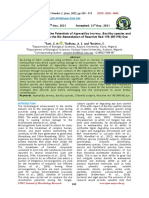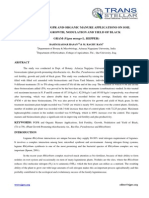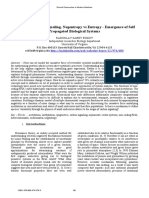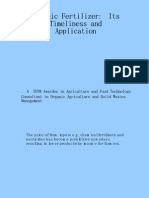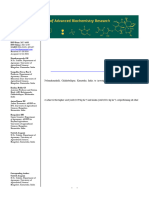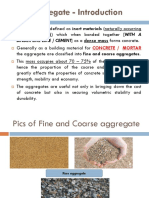tmpEDF7 TMP
tmpEDF7 TMP
Uploaded by
FrontiersCopyright:
Available Formats
tmpEDF7 TMP
tmpEDF7 TMP
Uploaded by
FrontiersOriginal Title
Copyright
Available Formats
Share this document
Did you find this document useful?
Is this content inappropriate?
Copyright:
Available Formats
tmpEDF7 TMP
tmpEDF7 TMP
Uploaded by
FrontiersCopyright:
Available Formats
Nature and Science 2015;13(2)
http://www.sciencepub.net/nature
The Synergistic Approach/ Action of Plants and Rhizobacteria in Crude Oil Contaminated Soil Remediation
in Nigeria.
Ukaegbu-Obi, K.M.*1 and Mbakwem-Aniebo, C.C.2
1
Department of Microbiology, College of Natural Sciences, Michael Okpara University of Agriculture, Umudike,
P.M.B 7267, Abia State, Nigeria.
2
Department of Microbiology, Faculty of Science, University of Port Harcourt, Choba, Rivers State, Nigeria.
*Corresponding author: kelechi.ukaegbuobi@yahoo.com
Abstract: The synergistic approach of plants and rhizobacteria in crude oil contaminated soil in three different
locations were carried out. The presence of heterotrophic bacteria and hydrocarbon-utilizing bacteria isolated from
the polluted and pristine rhizosphere and non-rhizosphere soils of the plants were compared. The polluted
rhizosphere of total culturable heterotrophic bacterial count gave a range of 0.98x106cfu/g to 1.37x106cfu/g. The
pristine rhizosphere count ranged from 4.11x105cfu/g to 7.55x105cfu/g. The polluted non-rhizosphere gave ranged
from 2.39x105cfu/g to 3.28x105cfu/g. The pristine non-rhizosphere had a range of 2.90x105cfu/g to 3.97x105cfu/g.
The polluted rhizosphere counts for hydrocarbon-utilizing bacteria ranged from 1.60x105cfu/g to 6.91x105 cfu/g.
The pristine rhizosphere gave a range of 1.85x105cfu/g to 3.38x105cfu/g. In the polluted non-rhizosphere, the range
was from 1.02x105cfu/g to 1.42x105cfu/g. A range of 6.05x104cfu/g to 9.75x104cfu/g was obtained from the pristine
non-rhizosphere. There was no significant difference (P>0.05) between the rhizosphere and non-rhizosphere of total
heterotrophic and hydrocarbon-utilizing bacterial counts in both polluted and pristine soils. All the plants exhibited
positive rhizosphere effects on the rhizobacteria. Hydrocarbon-utilizers were identified as Acinetobacter,
Arthrobacter, Alcaligenes, Bacillus, Corynebacterium, Flavobacterium, Micrococcus, Serratia and Pseudomonas
spp. All the isolates grew on petroleum hydrocarbon at different growth rates. Based on these results, the organisms
isolated can serve as seeds for bioaugmentation during remediation of crude oil polluted soil environment. The
plants may be employed in rhizoremediation of oil polluted soil.
[Ukaegbu-Obi, K.M. and Mbakwem-Aniebo, C.C. The Synergistic Approach/ Action of Plants and
Rhizobacteria in Crude Oil Contaminated Soil Remediation in Nigeria. Nat Sci 2015;13(2):1-5]. (ISSN: 15450740). http://www.sciencepub.net/nature. 1
Keywords: Plants, Synergistic approach, Crude oil, Bacteria, Phytoremediation, Soil, Rhizoremediatio
(Zhou et al., 2011). Partial or complete degradation of
organic substances have been demonstrated in some
cases (White, 2001). The use of plants to extract,
sequester or detoxify pollutants is therefore known as
phytoremediation (Gurska, 2009). Plants frequently do
not possess complete metabolic degradation pathway
for pollutants, and even more toxic by-products may
be produced.
Most plants have symbiotic relationships
with soil microorganisms. For example, root nodule
bacteria that have symbiotic relationships with
legumes are involved in Nitrogen fixation. The area
around plant roots, known as the rhizosphere contains
higher populations, greater diversities and activities of
microorganisms than soil with no plants (Nicholas et
al., 1997).
This synergistic approach of using plants and
their rhizobacteria in remediation of oil polluted soil is
known as rhizoremediation (Kuiper et al., 2004).
Application of the synergistic action of plants and
their rhizobacteria in crude oil contaminated soil
remediation have been demonstrated as an appropriate
and more practical alternative to clean-up of
1. Introduction
The usage of petroleum hydrocarbon
products has increased soil contamination. This is one
of the major environmental problems in Nigeria and
globally. Research efforts have been devoted to
develop new, low-cost, low-technology, eco-friendly
treatments capable of reducing and even eliminating
pollution in the atmosphere, the hydrosphere and soil
environments (Rao et al., 2010). To investigate the
countermeasure to remediate soils contaminated with
oils, bioremediation provide such an effective and
efficient strategy to speed up the clean-up processes.
Bioremediation of contaminated soil is low cost,
causes less interference with the soil structure and has
a higher public acceptance than other approaches
including soil thermal desorption and soil leaching
treatment (Tang et al, 2010).
Remediation of soils containing organic
pollutants can be enhanced by plants by various
processes (Cunningham et al., 1996). In-situ
phytoremediation strategy exploits natural or
genetically engineered plant species to accumulate
toxic substances (heavy metals, radioactive
compounds, organic pollutants) directly from the soil
Nature and Science 2015;13(2)
http://www.sciencepub.net/nature
petroleum hydrocarbon in the contaminated
environments.
A plant can be considered to be a solardriven biological pump and treatment system,
attracting water with its root system, accumulating
water-soluble pollutant in the rhizosphere and
concluding with the degradation or translocation of
pollutants (Liste and Alexander, 2000). In some
cases, rhizosphere microbes are even the main
contributors to the degradation process. Plants
release exudates into the soil ecosystem that
increases the microbial activity and aid the
degradation of xenobiobiotic substances. The
soluble root exudates include enzymes, amino acids,
sugars and low molecular weight carbohydrates
(Burken and Schnoor, 1996).
The objective of this study therefore was to
isolate rhizosphere-inhabiting indigenous oildegrading bacteria in plants growing in crude oilpolluted areas.
2. Materials and Methods
2.1 Study Site Description
Polluted rhizosphere and non-rhizosphere
soil samples were collected from the three different
crude oil polluted sites in Imo and Rivers States,
Nigeria. These sites could be described as recovering
ecosystems with few plants growing at these locations.
Unpolluted rhizosphere and non-rhizosphere soil
samples were collected from the same areas where
there has been no known crude oil pollution which
served as the control.
2.2 Collection of Soil Samples
Plants of the same species were collected
from the crude oil polluted and unpolluted sites in
separately in marked sterile plastic bags. The plants
were pulled out slowly to avoid breaking their roots.
Non-rhizosphere (bulk) soil samples of crude oil
polluted and unpolluted sites were collected at a
distance of thirty centimeters (30cm) from the plants
roots as described by Ukaegbu-Obi and MbakwemAniebo (2014) in marked sterile plastic bags and
transported in an ice chest to the laboratory for
analyses. The plants were taken to a Plant taxonomist
for identification.
2.3 Bacterial counts and isolation
The total culturable heterotrophic bacterial
(TCHB) count was determined using the spread plate
method on nutrient agar (Oxoid) according to Chikere
et al. (2009). Soil suspensions were prepared by 10
fold serial dilutions with 1 g of soil and then 10-3 to
10-6 dilutions were spread on the plates in duplicates.
The colony forming units of heterotrophs were
counted after incubation at 28C for 18 h.
Hydrocarbon utilizing bacteria (HUB) were
enumerated as adopted from Hamamura et al. (2008)
using mineral salts medium with crude oil supplied by
the vapour phase transfer. Isolated colonies were
further purified by subculturing and identified using
biochemical tests and microscopy.
2.4 Identification of Isolates
The bacterial isolates were examined for
colonial morphology, cell micro-morphology and
biochemical characteristics. Tests employed included:
Gram staining, Motility test, Catalase test, Citrate
Utilization test, Indole test, Hydrogen Sulphide
Production test, Methyl Red-Voges Proskauer test,
Oxidase test, Sugar Fermentation test. Confirmatory
identities of the bacteria were made using the Bergeys
Manual of Determinative Bacteriology (Holt, J.G.
(1994).
2.5 Screen Test for Hydrocarbon-Utilization by
Bacterial Isolates
The bacterial isolates were tested for their
ability to utilize crude oil using the turbidity method
as described by Ukaegbu-Obi and Mbakwem-Aniebo
(2014). The bacterial isolates were cultured in nutrient
broth and incubated at 28+20C for 24 hours. Aliquot
(0.1ml) of the young culture in nutrient broth grown
was inoculated into each test tube containing 9.9ml of
sterile mineral salt broth and 0.1ml of crude oil. A
control test tube containing 9.9ml of sterile mineral
salt broth plus 0.1ml of crude oil remained
uninoculated. The tubes were incubated at room
temperature for 7 days. The growth of the inocula was
determined by visual observation of the mineral salt
broth turbidity, as compared with the uninoculated
control tube.
2.6 Statistical Analysis
The statistical tools One-way Analysis of
Variance (ANOVA) was used to analyze the data
obtained from the plants while Independent Students
t-test was used to analyze the polluted and unpolluted
soil sample of each plant.
3. Results
Plant-assisted
bioremediation
(rhizoremediation) stands out as a potential tool to
inactivate or completely remove xenobiotics from the
polluted environment. Therefore, it is of key
importance to find an adequate combination of plant
species and microorganisms that together enhance the
clean-up process.
The results of the enumeration of the total
culturable heterotrophic bacterial counts of the
polluted and pristine rhizosphere and bulk soil are
shown in Figures 1-6. The total culturable
heterotrophic bacteria counts for polluted rhizosphere
ranged from 0.98x106cfu/g - 1.37 x 106 cfu/g, the
pristine rhizosphere (control), ranged from 4.20x105
cfu/g - 7.55 x 105 cfu/g; the polluted non-rhizosphere,
ranged from 2.56 x 105 cfu/g - 3.12 x 105cfu/g while
the pristine non-rhizosphere, ranged from 3.10 x
105cfu/g - 4.12 x105 cfu/g.
http://www.sciencepub.net/nature
Mean log HUB (cfu/g)
6
5.8
5.6
5.4
5.2
5
4.8
4.6
NonRhizosphere
Rhizosphere
Polluted
Mean log HUB (cfu/g)
NonRhizosphere
Zea mays
Parkia
Elaeis
Panicum
Polluted
Cyperus sp.
Polluted
Unpolluted
NonRhizosphere
Figure 5. Total heterotrophic bacterial counts of
polluted and pristine rhizosphere and non-rhizosphere
soils at location 3.
Unpolluted
Figure 2. Hydrocarbon utilizing bacterial counts of
polluted and pristine rhizosphere and non-rhizosphere
soils at location 1.
6
5.8
5.6
5.4
5.2
5
4.8
4.6
6
5.8
5.6
5.4
5.2
5
4.8
4.6
Unpolluted
7
6
5
4
3
2
1
0
Mimosa pudica
Alchorina cordifolia
Chromolaena ordorata
Chloris pilosa
Sida acuta
Mimosa pudica
Alchorina cordifolia
Chromolaena ordorata
Chloris pilosa
Sida acuta
Solenstemon sp.
Desmodium
Mariscus sp.
Phaseolus sp.
Cyperus
Mean log HUB (cfu/g)
Rhizosphere
Unpolluted
NonRhizosphere
Mimosa pudica
Alchorina cordifolia
Chromolaena
Chloris pilosa
Sida acuta
Mimosa pudica
Alchorina cordifolia
Chromolaena
Chloris pilosa
Sida acuta
Unpolluted
Figure 1. Total heterotrophic bacterial counts of
polluted and pristine rhizosphere and non-rhizosphere
soils at location 1.
6
5
4
3
2
1
0
Polluted
Figure 4. Hydrocarbon utilizing bacterial counts of
polluted and pristine rhizosphere and non-rhizosphere
soils at location 2.
Polluted
Mean log TCHC (cfu/g)
Solenstemon sp.
Desmodium
Mariscus sp.
Phaseolus sp.
Rhizosphere
Mean log TCHC (cfu/g)
6
5
4
3
2
1
0
Rhizosphere
Cyperus amabalis
Mean log TCHC (cfu/g)
The polluted rhizosphere counts for
hydrocarbon-utilizing
bacteria
ranged
from
1.60x105cfu/g to 6.91x105 cfu/g. The pristine
rhizosphere gave a range of 1.85x105cfu/g to
3.38x105cfu/g. In the polluted non-rhizosphere, the
range was from 1.02x105cfu/g to 1.42x105cfu/g. A
range of 6.05x104cfu/g to 9.75x104cfu/g was obtained
for pristine non- rhizosphere.
Cyperus sp.
Parkia sp.
Panicum
Zea mays
Elaeis guneensis
Cyperus sp.
Parkia sp.
Panicum
Zea mays
Elaeis guneensis
Nature and Science 2015;13(2)
Rhizosphere
Rhizosphere
Non-Rhizosphere
Polluted
Unpolluted
NonRhizosphere
Figure 6. Hydrocarbon utilizing bacterial counts of
polluted and pristine rhizosphere and non-rhizosphere
soils at location 3.
Figure 3. Total heterotrophic bacterial counts of
polluted and pristine rhizosphere and non-rhizosphere
soils at location 2.
Nature and Science 2015;13(2)
http://www.sciencepub.net/nature
pristine soils agreed with the previous reports by
Umanu et al. (2013) and Ukaegbu-Obi and
Mbakwem-Aniebo, (2014) which could be attributed
to the toxic effect of petroleum-pollution. Microbial
community structure has been recommended as a
biological indicator of heavy metal stress.
Unlike the result of total culturable
heterotrophic count, in the non-rhizosphere soil, the
mean counts of the hydrocarbon-utilizing bacteria
were higher in the contaminated non-rhizosphere soil
for all the plants (Figures 2, 4 and 6). This finding was
also reported by Leahy and Colwell (1990) and
Ukaegbu-Obi and Mbakwem-Aniebo (2014) who
observed that hydrocarbon-utilizing bacteria and fungi
were readily isolated from soil and also that the
application of oil or oily waste to soil resulted in
increased numbers of hydrocarbon-utilizing bacteria
and fungi. This phenomenon of selective enrichment
causes the numbers of microorganisms that can utilize
the compound of interest to increase within the
community (Leahy and Colwell, 1990). The addition
of crude oil results in an immediate change in
bacterial community structure, increasing abundance
of hydrocarbon degrading microorganisms and a
rapid rate of oil degradation, which suggests the
presence of a pre-adapted oil-degrading microbial
community and sufficient supply of nutrients
(Hamamura et al., 2008).
The rhizosphere (both polluted and pristine)
had higher frequencies of occurrence of bacterial
isolates than the non-rhizosphere. This result may
indicate the fact that vegetation influences some
specific degradative groups of bacteria already present
in the polluted sites than the total microbial diversity.
Juhason et al. (2007) reported that in their field
experiment phytoremediation increased the number of
phenol-degrading bacteria in semi-coke (processed oil
shale solid wastes) as well as metabolic diversity of
microbial community. Exudates derived from plants
can help to stimulate the survival and action of
bacteria, which subsequently results in more efficient
degradation of pollutants (Kuiper et al,. 2004).
The bacterial isolates obtained from different
rhizosphere and non-rhizosphere of polluted and
pristine soils in this study were identified to be of the
following genera: Acinetobacter, Alcaligenes,
Arthrobacter,
Bacillus,
Corynebacterium,
Flavobacterium, Micrococcus and Pseudomonas and
Serratia. This agrees with the findings of (Tesar et al.,
2002) who reported that a broad phylogenetic range of
bacteria including species/strains of Achromobacter,
Acidovorax, Alcaligenes, Arthrobacter, Bacillus,
Corynebacterium, Flavobacterium, Micrococcus,
Mycobacterium,
Norcadia,
Pseudomonas,
Rhodococcus, Sphinogomonas and Xanthomonas have
been identified in the breakdown of hydrocarbons.
Table 1: Screen Test for the Utilization of Petroleum
Hydrocarbon by the Bacterial Isolates
Isolate
Growth In Bacterial Isolate Crude Oil
Code
Medium
PRO 1A
++
Arthrobacter sp.
PSO 2B
++
Corynebacterium sp.
PSO 3A
++
Alcaligenes sp.
PRO 5A
++
Acinetobacter sp.
NSO 1B
++
Pseudomonas sp.
NSO 2A
+
Flavobacterium sp.
NRO 3A
+
Arthrobacter sp.
NRO 3A
+
Serratia sp.
NRO 4B
++
Pseudomonas sp.
NRO 5B
+
Corynebacterium sp.
PRU 1A
++
Flavobacterium sp.
PSU 2B
++
Micrococcus sp.
PRU 3A
++
Alcaligenes sp.
PSU 3A
++
Bacillus sp.
PRU 3B
+++
Pseudomonas sp.
PRU 1B
+
Arthrobacter sp.
NSU 4B
+
Arthrobacter sp.
NRU 5B
++
Acinetobacter sp.
PSA 1A
++
Bacillus sp.
PRA 4B
++
Bacillus sp.
PRA 5A
+++
Pseudomonas sp.
NSA 3A
+
Acinetobacter sp.
NRA 2B
+
Micrococcus sp.
4 Discussions
Field trials have shown that remediation of
petroleum contaminated sites can be enhanced by
cultivation of plants. To date, a great variety of
grasses, legumes and fast growing trees with high
transpiration rates such as poplars, alder or willow
have been applied for phytoremediation. These plants
provide large surface area for root soil contact due to
their expansive root system. Roots also provide ideal
attachment
sites
for
microbes
and
food
supply/exudates consisting of amino acid, organic
acids, sugars, enzymes and complex carbohydrate
(Tesar et al., 2002).
It was observed that the total heterotrophic
bacterial counts were higher in the polluted
rhizosphere than in the polluted non-rhizosphere of all
the plants. This was the same for hydrocarbonutilizing bacteria; the counts were also higher in the
polluted rhizosphere than the polluted nonrhizosphere. Lynch (1990) stated that on a per gram
basis, rhizosphere soil has 10100 times more
microbes than unvegetated soil. This expresses the
rhizosphere effect of the plants on the bacteria.
The low counts of heterotrophic bacteria
(Figures 1, 3 and 5) recorded in this study for most
crude oil-contaminated soils compared to that of
Nature and Science 2015;13(2)
http://www.sciencepub.net/nature
The bacterial isolates utilized crude oil at
different rates with Pseudomonas sp. having the
highest growth rate followed by Bacillus sp.,
Acinetobacter sp., Alcaligenes sp., Micrococcus sp.,
and Corynebacterium sp., that had moderate growth
rate and Arthrobacter sp., Flavobacterium sp.,
Micrococcus sp., Serratia sp. having scanty growth
rates (Table 1). Some isolates may withstand toxic
components of the oil and thrive, others may be
inhibited. Other investigators (Ibrahim et al., 2008)
have made similar observations. The result also
showed that some bacteria isolated from
uncontaminated sites had the potential to utilize crude
oil but these potentials were not as high as their
counterparts isolated from contaminated sites.
Conclusion
The use of plants for rehabilitation of crude
oil contaminated environments is an emerging area of
interest because it provides an ecologically sound and
safe method for restoration and remediation. A clever
solution is to combine the advantages of microbeplant symbiosis within the plant rhizosphere into an
effective cleanup technology as this may be a
promising strategy to remediate more contaminated
sites.
Corresponding Author:
Ukaegbu-Obi, K.M.
Department of Microbiology,
College of Natural Sciences,
Michael Okpara University of Agriculture,
Umudike, P.M.B 7267, Abia State, Nigeria.
Email: kelechi.ukaegbuobi@yahoo.com
6.
7.
8.
9.
10.
11.
12.
13.
14.
15.
References
1.
2.
3.
4.
5.
Rao, MA., Scelza, R. Scotti, R and Gianfreda, L. Role
of enzymes in the remediation of polluted
environments. J. soil sci. plant nutr., 2010; 10 (3):
333- 353.
Tang, JC.,Wang, RG., Niu, XW., Wang, M., Chu, HR.
and
Zhou,
QX.
Characterisation
of
the
rhizoremediation of petroleum-contaminated soil:
effect of different influencing factors. Biogeosciences,
2010; 7: 39613969.
Cunningham, SD., Anderson, TA., Schwab, V and
Hsu, FC. Phytoremediation Of Soils Contaminated
With Organic Pollutants. Adv. Argon., 1996; 56:55114.
Zhou, Q., Cai, Z., Zhang, Z. And Liu, W. Ecological
Remediation of Hydrocarbon Contaminated Soils with
Weed Plant. J. Resour. Ecol., 2011; 2(2) 97-105.
DOI:10.3969/j.issn.1674-764x.2011.02.001.
White,
P.
Phytoremediation
Assisted
by
Microorganisms. Trends Plant Sci., 2001; 6: 502.
16.
17.
18.
19.
20.
1/23/2015
Gurska, J., Wang, WX., Gerhardt, K.E., Khalid, AM.,
Isherwood, DM., Huang, XD., Glick, BR., and
Greenberg, BM.. Three year field test of a plant
growth
promoting
rhizobacteria
enhanced
phytoremediation system at a land farm for treatment
of hydrocarbon waste. Environ. Sci. Technol.
2009;43(12): 44724479.
Nicholas, TD, Wolf, DC, Rogers, HB, Beyrouty, CA
and Reynolds, CM. Rhizosphere Microbial Population
in Contaminated Soil. Water, Air Soil Pollut., 1997;
95: 165 178.
Kuiper, I, Lagendijk, EL Bloemberg GV and
Lugtenberg BJJ. Rhizoremediation: A beneficial plantmicrobe interaction. Mol. Plant-Microbe Interact.,
2004; 17(1):6-15.
Liste, HH and Alexander, M. Plant Promoted Pyrene
Degradation in Soil. Chemosphere, 2000; 40:7-10.
Burken, JG and Schnoor, JDL. Phytoremedation: Plant
Uptake of Atrazine and Role of Root Exudates. J.
Environ. Eng, 1996; 122: 958963.
Ukaegbu-Obi, KM and Mbakwem-Aniebo, CC.
Bioremediation Potentials of Bacteria Isolated from
Rhizosphere of Some Plants of Oil Contaminated Soil
of Niger Delta. J Appld & Envt. Microbiology, 2014;
2(4):194-197. DOI:10.12691/jaem-2-4-13.
Chikere, CB, Okpokwasili, GC and Chikere, BO.
Bacterial diversity in a tropical crude oil-polluted soil
undergoing bioremediation. African J Biotech., 2009;
8 (11): 2535-2540
Hamamura, N, Olson, SH, Ward, DM and Inskeep,
WP. Microbial population dynamics associated with
crude-oil biodegradation in diverse soils. Appld
Environ. Microbiology, 2008;72: 6316 6324.
Holt, JG. Bergeys Manual of Determinative
Bacteriology. 9th edition. Williams and Wilkins Pub.
Co. Baltimore, Maryland, USA. 1994;787
Tesar, M., Reichenauer, TG and Sessitsch, A.
Bacterial rhizosphere populations of blank poplar and
herbal plants to be used for phytoremediation. J. Soil
Biol. Biochem., 2002; 34:1883- 1892.
Lynch, JM. The Rhizosphere. Wiley, New York. 1990.
Umanu, G, Akpe, AR and Omoikhudu, AR Oil
Degradation Assessment of Bacteria Isolated from
Used Motor Oil Contaminated Soils in Ota, Nigeria.
I.J.A.B.R. 2013; 3(4): 506-513. ISSN 2250 3579.
Leahy, JG and Colwell, RR. Microbial degradation of
hydrocarbons in the environment. Microbial. Rev,
1990; 54: 305 315.
Juhanson, J, Truu, J, Heinaru, E and Heinaru, A.
Temporal Dynamics of Microbial Community in Soil
during Phytoremediation Field Experiment. JEELM,
2007;15(4): 213-220.
Ibrahim, MLU, Ijah, JJ, Manga, SB and Rabah, AB.
Occurrence of hydrocarbon utilizing bacteria in the
rhizosphere of Eucalyptus camaldulensis, Lablab
purpureus
and
Moringa
oleifera.
IJPAS.
2008;2(3):2126.
You might also like
- Geosynthetics For Ground Improvement of Embankments On SoftDocument28 pagesGeosynthetics For Ground Improvement of Embankments On SoftkonetinarendraNo ratings yet
- Pseudomonas Aeruginosa On The Organic ContentDocument8 pagesPseudomonas Aeruginosa On The Organic ContentIJEAB JournalNo ratings yet
- Bioremediation of Crude Oil Contaminated Soils Using Cow Dung As Bioenhancement AgentDocument5 pagesBioremediation of Crude Oil Contaminated Soils Using Cow Dung As Bioenhancement AgentAlka PriyadarshiniNo ratings yet
- Impact of Diazotrophic Bacteria On Germination and Growth of Tomato, With Bio-Control Effect, Isolated From Algerian SoilDocument7 pagesImpact of Diazotrophic Bacteria On Germination and Growth of Tomato, With Bio-Control Effect, Isolated From Algerian SoilsaidaNo ratings yet
- Bioremediation of Glyphosate Polluted Soil Using Fungal SpeciesDocument7 pagesBioremediation of Glyphosate Polluted Soil Using Fungal SpeciesEditor IJTSRDNo ratings yet
- Hydrocarbon Degradation and Enzyme Activities of Aspergillus Oryzae and Mucor Irregularis Isolated From Nigerian Crude Oil-Polluted SitesDocument19 pagesHydrocarbon Degradation and Enzyme Activities of Aspergillus Oryzae and Mucor Irregularis Isolated From Nigerian Crude Oil-Polluted SitesTassioNo ratings yet
- Effect of Long-Term Organic Fertilizer Application On Soil Microbial DynamicsDocument4 pagesEffect of Long-Term Organic Fertilizer Application On Soil Microbial Dynamicskhanhduy230305No ratings yet
- Welcome To International Journal of Engineering Research and Development (IJERD)Document6 pagesWelcome To International Journal of Engineering Research and Development (IJERD)IJERDNo ratings yet
- 10.11648.j.ajac.20221004.11Document6 pages10.11648.j.ajac.20221004.11dawit gNo ratings yet
- Effect of Different Substrates On Vegetative Growth Characters of Tomato (Solanum Lycopersicum)Document8 pagesEffect of Different Substrates On Vegetative Growth Characters of Tomato (Solanum Lycopersicum)International Journal of Innovative Science and Research TechnologyNo ratings yet
- ProspectusDocument13 pagesProspectusAkash Kumar SahuNo ratings yet
- Response of The Use of Organic Fertilizer and Mulch To The Growth and Yield of Pumpkin (Cucurbita Moschata)Document7 pagesResponse of The Use of Organic Fertilizer and Mulch To The Growth and Yield of Pumpkin (Cucurbita Moschata)International Journal of Innovative Science and Research TechnologyNo ratings yet
- In Vitro Assessment of IAA Production and Antibiotics Tolerance of Peanut (Arachis Hypogeae L.) Nodulating BacteriaDocument7 pagesIn Vitro Assessment of IAA Production and Antibiotics Tolerance of Peanut (Arachis Hypogeae L.) Nodulating BacteriaInternational Journal of Innovative Science and Research TechnologyNo ratings yet
- The Effect of Seaweed Extract On Tomato Plant GrowDocument11 pagesThe Effect of Seaweed Extract On Tomato Plant GrowtummalaajaybabuNo ratings yet
- Chlorella Vulgaris On The Bio-Remediation of Reactive Red 198 (RR198) DyeDocument7 pagesChlorella Vulgaris On The Bio-Remediation of Reactive Red 198 (RR198) DyeUMYU Journal of Microbiology Research (UJMR)No ratings yet
- Murdoc StrainDocument5 pagesMurdoc StraingetachewmkNo ratings yet
- ActinimycetesDocument9 pagesActinimycetesSumedhaNo ratings yet
- Tamizhazhagan 5Document3 pagesTamizhazhagan 5TamizhazhaganNo ratings yet
- Phytotoxicity and Microbial Activities of Crude Oil Polluted Pristine Soil During Bioremediation With Saw Dust Amendment From Awka, NigeriaDocument8 pagesPhytotoxicity and Microbial Activities of Crude Oil Polluted Pristine Soil During Bioremediation With Saw Dust Amendment From Awka, NigeriaEditor IJTSRDNo ratings yet
- Preliminary Investigations On Selection of Synergistic Halotolerant Plant Growth Promoting Rhizobacteria For Inducing Salinity Tolerance in WheatDocument11 pagesPreliminary Investigations On Selection of Synergistic Halotolerant Plant Growth Promoting Rhizobacteria For Inducing Salinity Tolerance in WheatTahiri AbdelilahNo ratings yet
- Ajabssp 2009 146 151Document6 pagesAjabssp 2009 146 151Hilma Dianti MarhamNo ratings yet
- Modeling Palm Bunch Ash Enhanced Bioremediation of Crude-Oil Contaminated SoilDocument5 pagesModeling Palm Bunch Ash Enhanced Bioremediation of Crude-Oil Contaminated SoilInternational Journal of Science and Engineering InvestigationsNo ratings yet
- Jurnal Identifikasi Keberagaman Bakteri Pada Commercial SeedDocument11 pagesJurnal Identifikasi Keberagaman Bakteri Pada Commercial SeedTaufiq AliNo ratings yet
- Bio-Methanation of Marine Cyanobacteria and Seaweed Biomass For Biogas Production by Co-Digestion With Slaughter House WasteDocument9 pagesBio-Methanation of Marine Cyanobacteria and Seaweed Biomass For Biogas Production by Co-Digestion With Slaughter House WasteijsidonlineinfoNo ratings yet
- Watering Pennisetum Purpureum Daily PhytoremediationDocument7 pagesWatering Pennisetum Purpureum Daily Phytoremediationgerind acNo ratings yet
- Soybean My Paper 2Document13 pagesSoybean My Paper 2Shourav RoyNo ratings yet
- Ujps3 10315523Document5 pagesUjps3 10315523Felimar CalaNo ratings yet
- Effect of Biosurfactant From Two Strains ofDocument6 pagesEffect of Biosurfactant From Two Strains ofjeanpiereNo ratings yet
- Studies On Callus Induction and Shoot Regeneration in TomatoDocument5 pagesStudies On Callus Induction and Shoot Regeneration in TomatoMogleNo ratings yet
- Comparison of Aerobic and Anaerobic Bioremediation of Polluted Water SamplesDocument7 pagesComparison of Aerobic and Anaerobic Bioremediation of Polluted Water SamplesMusa MohammadNo ratings yet
- Research Proposal DraftDocument32 pagesResearch Proposal DraftjojeNo ratings yet
- International Journal of Engineering and Science Invention (IJESI)Document5 pagesInternational Journal of Engineering and Science Invention (IJESI)inventionjournalsNo ratings yet
- 1 PBDocument10 pages1 PBHannihNo ratings yet
- Estiercol de CabraDocument6 pagesEstiercol de CabraNestor Daniel Romero GarciaNo ratings yet
- Rapid bioassays to evaluate the plant growth promoting activity of Ascophyllum nodosum (L.) Le Jol. using a model plant, Arabidopsis thaliana (L.) HeynhDocument7 pagesRapid bioassays to evaluate the plant growth promoting activity of Ascophyllum nodosum (L.) Le Jol. using a model plant, Arabidopsis thaliana (L.) Heynhluis.rios.lobos93No ratings yet
- Cerqueira 2014. Comparison of Bioremediation Strategies For Soil Impacted With Petrochemical Oily SludgeDocument8 pagesCerqueira 2014. Comparison of Bioremediation Strategies For Soil Impacted With Petrochemical Oily SludgeDajathNo ratings yet
- Jurnal Bahasa Inggris AyunDocument8 pagesJurnal Bahasa Inggris AyunAyun AriniNo ratings yet
- ManuscriptDocument18 pagesManuscriptJOHNNo ratings yet
- Issn 1314-7234, Volume 17, 2023: Ecology & Safety International Scientific PublicationsDocument8 pagesIssn 1314-7234, Volume 17, 2023: Ecology & Safety International Scientific PublicationsM.belhajmedNo ratings yet
- Cabanillas Galvez George Art. 02Document11 pagesCabanillas Galvez George Art. 02George CabanillasNo ratings yet
- Production of Bio-Gas From Flowers and V PDFDocument5 pagesProduction of Bio-Gas From Flowers and V PDFCamilo Enrique Monroy CardenasNo ratings yet
- JPNSSDocument6 pagesJPNSSrinu_ammaNo ratings yet
- Isolation of Soil FungiDocument7 pagesIsolation of Soil FungiShanmugaprakasham ShanNo ratings yet
- Characteristics and Antifungal Effect of Composts On FusariumDocument9 pagesCharacteristics and Antifungal Effect of Composts On FusariumOpenaccess Research paperNo ratings yet
- Collection and Analysis of Root Exudates of Festuca Arundinacea L. and Their Role in Facilitating The Phytoremediation of Petroleum-Contaminated SoilDocument11 pagesCollection and Analysis of Root Exudates of Festuca Arundinacea L. and Their Role in Facilitating The Phytoremediation of Petroleum-Contaminated SoilJanet AngelesNo ratings yet
- Using Solid Food Waste in HydroponicsDocument6 pagesUsing Solid Food Waste in HydroponicsHarry Hart100% (1)
- IOSR JournalsDocument7 pagesIOSR JournalsInternational Organization of Scientific Research (IOSR)No ratings yet
- Assesment of Biofertilizer Quality and Health Implications of Anaerobic Digestion Effluent of Cow Dung and Chicken Droppings PDFDocument6 pagesAssesment of Biofertilizer Quality and Health Implications of Anaerobic Digestion Effluent of Cow Dung and Chicken Droppings PDFSergio ArangoNo ratings yet
- African Journal of Biotechnology Bioreme PDFDocument7 pagesAfrican Journal of Biotechnology Bioreme PDFkarnah nurwendahNo ratings yet
- Mycoremediation of Hydrocarbon and Its Products Using FusariumDocument9 pagesMycoremediation of Hydrocarbon and Its Products Using FusariumVenkatNo ratings yet
- Toxicity of The Antimicrobial Oxytetracycline To Soil Organisms in A Multi-Species-Soil System (MSDocument9 pagesToxicity of The Antimicrobial Oxytetracycline To Soil Organisms in A Multi-Species-Soil System (MSCarolina Ivon Inostroza HuaracànNo ratings yet
- Production of Coriander (Coriandrum Sativum L.) in Organic Substrates and Fertigation With Biodigester EffluentsDocument4 pagesProduction of Coriander (Coriandrum Sativum L.) in Organic Substrates and Fertigation With Biodigester EffluentsIJAERS JOURNALNo ratings yet
- Toppo and Nail 2015Document9 pagesToppo and Nail 2015Alan Rivera IbarraNo ratings yet
- 1 s2.0 S0254629922006731 MainDocument10 pages1 s2.0 S0254629922006731 MainJosé Luis Álvarez CruzNo ratings yet
- Agri Sci - IJASR - Evaluation of PGPR and Organic - Basim Kassar HasanDocument10 pagesAgri Sci - IJASR - Evaluation of PGPR and Organic - Basim Kassar HasanTJPRC Publications100% (1)
- 21B-4007Document9 pages21B-4007b.cristycadaoNo ratings yet
- Isolation and Characterization of Effective Bacteria For Solid Waste Degradation For Organic ManureDocument12 pagesIsolation and Characterization of Effective Bacteria For Solid Waste Degradation For Organic ManureadebestechNo ratings yet
- Bioremediation of Textile Dyes by Fungal-Bacterial BiofilmsDocument8 pagesBioremediation of Textile Dyes by Fungal-Bacterial BiofilmsIJEAB JournalNo ratings yet
- Chapter One TianaDocument9 pagesChapter One TianaabdulkadirumarusmanNo ratings yet
- Dashti Et al-2019-MicrobiologyOpenDocument12 pagesDashti Et al-2019-MicrobiologyOpenじょしら フィアンナNo ratings yet
- tmpF178 TMPDocument15 pagestmpF178 TMPFrontiersNo ratings yet
- tmpE3C0 TMPDocument17 pagestmpE3C0 TMPFrontiersNo ratings yet
- Tmp1a96 TMPDocument80 pagesTmp1a96 TMPFrontiersNo ratings yet
- tmp998 TMPDocument9 pagestmp998 TMPFrontiersNo ratings yet
- Tmp75a7 TMPDocument8 pagesTmp75a7 TMPFrontiersNo ratings yet
- tmp3656 TMPDocument14 pagestmp3656 TMPFrontiersNo ratings yet
- tmp96F2 TMPDocument4 pagestmp96F2 TMPFrontiersNo ratings yet
- tmpA7D0 TMPDocument9 pagestmpA7D0 TMPFrontiersNo ratings yet
- tmp97C8 TMPDocument9 pagestmp97C8 TMPFrontiersNo ratings yet
- Phosphorus in Dairy Cattle DietsDocument4 pagesPhosphorus in Dairy Cattle DietsDiego F. PardoNo ratings yet
- Biofertilizer Technology ManualDocument39 pagesBiofertilizer Technology ManualneharockNo ratings yet
- The Living Soil: A Lifetime Journey in Understanding It For Human SustenanceDocument61 pagesThe Living Soil: A Lifetime Journey in Understanding It For Human SustenancePatrick P MusesengwaNo ratings yet
- AAT Manual English PDFDocument12 pagesAAT Manual English PDFAlessander FagundesNo ratings yet
- Water Logging - SalinityDocument13 pagesWater Logging - SalinityVedant Patel100% (1)
- GW Year Book 22-23Document110 pagesGW Year Book 22-23ashi.justforstorageNo ratings yet
- Isolation of Soil FungiDocument7 pagesIsolation of Soil FungiShanmugaprakasham ShanNo ratings yet
- Earth & Life Science: Teacher: Maricris D. Ravanilla Lesson 1: EARTHDocument6 pagesEarth & Life Science: Teacher: Maricris D. Ravanilla Lesson 1: EARTHSeanneira LacsonNo ratings yet
- Plantmate Aud & NZ 2Document98 pagesPlantmate Aud & NZ 2rohitpnfNo ratings yet
- Geo - Session 4 Chapter 6-9Document7 pagesGeo - Session 4 Chapter 6-9Heart VenturanzaNo ratings yet
- Index Properties2Document25 pagesIndex Properties2Ian Christopher Lagaya CuevasNo ratings yet
- Grain Size Analysis by Wet and Dry Sieve Analysis: 1. ObjectiveDocument4 pagesGrain Size Analysis by Wet and Dry Sieve Analysis: 1. ObjectiveMuhammad AfrasiyabNo ratings yet
- EHG BrochureDocument12 pagesEHG BrochureRob ChandlerNo ratings yet
- Bio FertilizersforOrganicAgricultureDocument7 pagesBio FertilizersforOrganicAgriculturenimra imtiazNo ratings yet
- DPR JPNagar-4Document126 pagesDPR JPNagar-4Suhail AhmedNo ratings yet
- 8-12-37-830Document6 pages8-12-37-8308834: Shanthanagowda GmNo ratings yet
- Sand & AggregateDocument75 pagesSand & AggregateCBIT CIVIL A1100% (2)
- Phoon y Kulhawy (1999)Document18 pagesPhoon y Kulhawy (1999)German RodriguezNo ratings yet
- Geotechnical GlossaryDocument31 pagesGeotechnical GlossaryClaudia SilvaNo ratings yet
- Literature Review On Conservation AgricultureDocument4 pagesLiterature Review On Conservation Agricultureafmztvjdbizbam100% (1)
- NarcDocument4 pagesNarcLybah RehmanNo ratings yet
- 20210504-Std - VIII2. G - NATURAL RESOURCES - LAND, SOIL, WATER, NATURAL VWGETATION AND WILD LIFEDocument4 pages20210504-Std - VIII2. G - NATURAL RESOURCES - LAND, SOIL, WATER, NATURAL VWGETATION AND WILD LIFEHardik KarelNo ratings yet
- Quadrus Mat BrochureDocument5 pagesQuadrus Mat BrochureIbrahim SahinNo ratings yet
- 040 Development and Performance Testing of Two Row Paddy Transplanter (2012) PDFDocument92 pages040 Development and Performance Testing of Two Row Paddy Transplanter (2012) PDFMaria RicNo ratings yet
- Building Department Faculty of Architechture, Planning and Surveying University Technology Mara Shah AlamDocument12 pagesBuilding Department Faculty of Architechture, Planning and Surveying University Technology Mara Shah AlamRaz FaizmeirNo ratings yet
- Calculation Summary of Pile FoundationDocument24 pagesCalculation Summary of Pile FoundationdedydarwisNo ratings yet
- Management of Sustainable AgricultureDocument119 pagesManagement of Sustainable AgricultureFlorinel DNo ratings yet
- Crops in India GK Notes in PDFDocument17 pagesCrops in India GK Notes in PDFPintu Kumar100% (1)
- K Factor in Ecuadorian Basins CompressedDocument15 pagesK Factor in Ecuadorian Basins CompressedDaniel Alfredo Delgado GutierrezNo ratings yet














